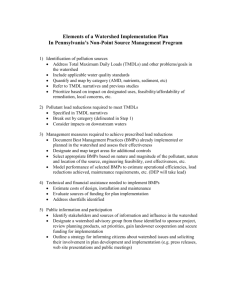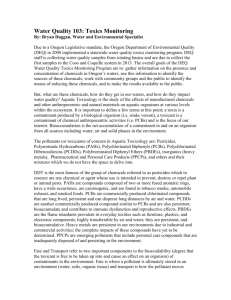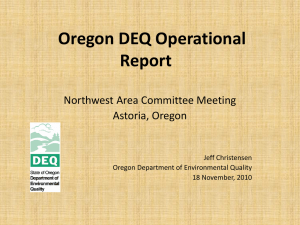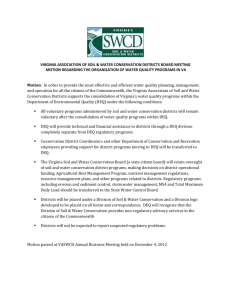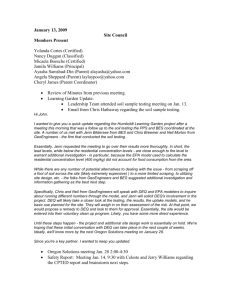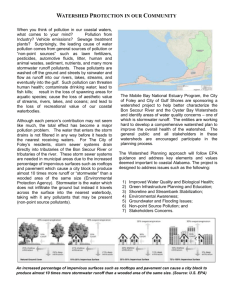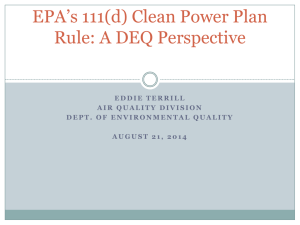3-1-04 Umatilla session
advertisement
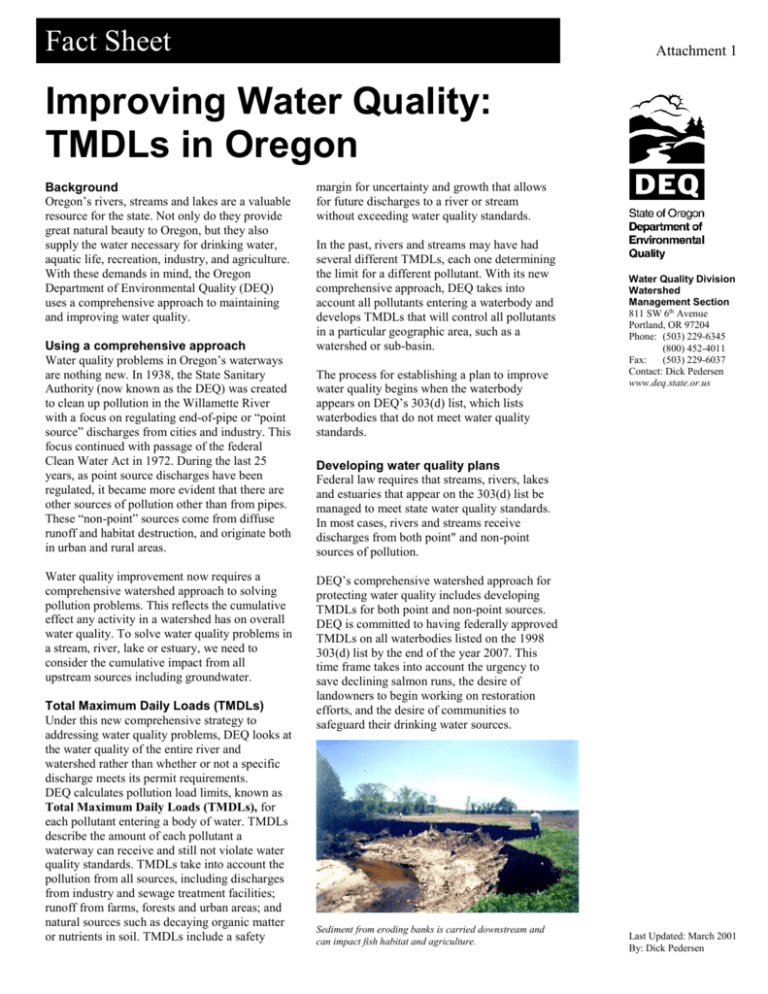
Fact Sheet Attachment 1 Improving Water Quality: TMDLs in Oregon Background Oregon’s rivers, streams and lakes are a valuable resource for the state. Not only do they provide great natural beauty to Oregon, but they also supply the water necessary for drinking water, aquatic life, recreation, industry, and agriculture. With these demands in mind, the Oregon Department of Environmental Quality (DEQ) uses a comprehensive approach to maintaining and improving water quality. Using a comprehensive approach Water quality problems in Oregon’s waterways are nothing new. In 1938, the State Sanitary Authority (now known as the DEQ) was created to clean up pollution in the Willamette River with a focus on regulating end-of-pipe or “point source” discharges from cities and industry. This focus continued with passage of the federal Clean Water Act in 1972. During the last 25 years, as point source discharges have been regulated, it became more evident that there are other sources of pollution other than from pipes. These “non-point” sources come from diffuse runoff and habitat destruction, and originate both in urban and rural areas. Water quality improvement now requires a comprehensive watershed approach to solving pollution problems. This reflects the cumulative effect any activity in a watershed has on overall water quality. To solve water quality problems in a stream, river, lake or estuary, we need to consider the cumulative impact from all upstream sources including groundwater. Total Maximum Daily Loads (TMDLs) Under this new comprehensive strategy to addressing water quality problems, DEQ looks at the water quality of the entire river and watershed rather than whether or not a specific discharge meets its permit requirements. DEQ calculates pollution load limits, known as Total Maximum Daily Loads (TMDLs), for each pollutant entering a body of water. TMDLs describe the amount of each pollutant a waterway can receive and still not violate water quality standards. TMDLs take into account the pollution from all sources, including discharges from industry and sewage treatment facilities; runoff from farms, forests and urban areas; and natural sources such as decaying organic matter or nutrients in soil. TMDLs include a safety margin for uncertainty and growth that allows for future discharges to a river or stream without exceeding water quality standards. In the past, rivers and streams may have had several different TMDLs, each one determining the limit for a different pollutant. With its new comprehensive approach, DEQ takes into account all pollutants entering a waterbody and develops TMDLs that will control all pollutants in a particular geographic area, such as a watershed or sub-basin. The process for establishing a plan to improve water quality begins when the waterbody appears on DEQ’s 303(d) list, which lists waterbodies that do not meet water quality standards. Water Quality Division Watershed Management Section 811 SW 6th Avenue Portland, OR 97204 Phone: (503) 229-6345 (800) 452-4011 Fax: (503) 229-6037 Contact: Dick Pedersen www.deq.state.or.us Developing water quality plans Federal law requires that streams, rivers, lakes and estuaries that appear on the 303(d) list be managed to meet state water quality standards. In most cases, rivers and streams receive discharges from both point" and non-point sources of pollution. DEQ’s comprehensive watershed approach for protecting water quality includes developing TMDLs for both point and non-point sources. DEQ is committed to having federally approved TMDLs on all waterbodies listed on the 1998 303(d) list by the end of the year 2007. This time frame takes into account the urgency to save declining salmon runs, the desire of landowners to begin working on restoration efforts, and the desire of communities to safeguard their drinking water sources. Sediment from eroding banks is carried downstream and can impact fish habitat and agriculture. Last Updated: March 2001 By: Dick Pedersen When establishing TMDL limits, DEQ: Reviews existing data and monitors to determine what pollutant is causing water quality problems and in what amounts it is entering the water. The review and monitoring also attempts to determine how much of the pollution comes from point sources, non-point pollution, such as surface runoff, and how much is naturally occurring. Uses techniques such as computer models to determine what affect the pollution is having on the stream or river, and how much of the pollutant can be discharged without exceeding water quality standards in the watershed. Uses this information to establish permit limits on the amount of pollutant each pipe can discharge and limits on non-point sources that are controlled through various water quality management plans. This comprehensive approach focuses on watershed plans developed locally. How plans are developed Management plans to restore streams and rivers to water quality standards will be developed by government agencies in cooperation with landowners. If the land adjacent to a waterbody is agricultural, then the Oregon Department of Agriculture would work with the landowners in the watershed to devise and implement a management plan (as stipulated by Senate Bill 1010). If the land is private or state forest, then the Oregon Department of Forestry implements the Forest Practices Act. Federal agencies (such the U.S. Forest Service or the Bureau of Land Management) would have responsibility to develop watershed management plans for federal lands. In urban and rural areas not covered by other state or federal agencies, cities and counties would develop management plans, working closely with local watershed councils. These plans are sent to DEQ for inclusion in an overall water quality management plan, which DEQ then submits to the U.S. Environmental Protection Agency (EPA) along with the TMDL. EPA has the responsibility for approving the TMDL. Not all basins will have TMDLs developed at once. DEQ has prioritized the order for allocating resources to develop TMDLs through the year 2007. Protecting our future Through careful planning and through such approaches as the Total Maximum Daily Load, we can not only address pollution today but also maintain the quality of Oregon’s waterways for the future. For more information about TMDLs, or about how you can help prevent water pollution, write the Oregon Department of Environmental Quality, Water Quality Division, 811 SW Sixth Ave., Portland, OR, 97204. You may also contact Dick Pedersen, Watershed Management Section Manager, at (503) 229-6345. Further information on TMDLs and other programs can be found at DEQ’s Web site at www.deq.state.or.us This document is available in an alternative format (e.g. large type or Braille) by calling DEQ’s Office of Communications & Outreach at (503) 229-5766 or (toll-free within Oregon) 1800-452-4011. People with hearing impairments may call DEQ’s TTY line at (503) 229-6993. Riparian shade is an important component for maintaining cool stream temperatures.
